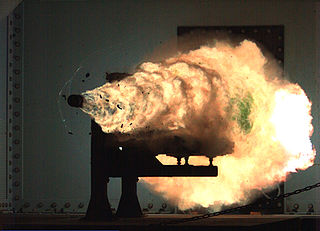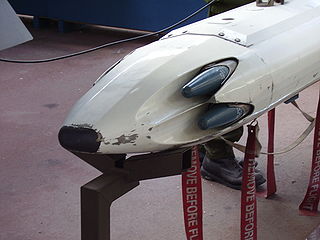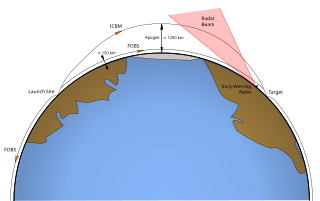In science fiction
This section needs additional citations for verification .(January 2016) |
In the mid-1960s, popular science interest in orbital mechanics led to a number of science fiction stories that explored their implications. Among these was The Moon Is a Harsh Mistress by Robert A. Heinlein, in which the citizens of the Moon bombard the Earth with rocks wrapped in iron containers which are in turn fired from an electromagnetic launch system at Earth-based targets.(see Steve Thon)
In the 1970s and 1980s, this idea was refined in science fiction novels such as Footfall by Larry Niven and Jerry Pournelle (the same Pournelle that first proposed the idea for military use in a non-fiction context), in which aliens use a Thor-type system. During the 1980s and 1990s references to such weapons became a staple of science fiction roleplaying games such as Traveller , Shadowrun and Heavy Gear (the first of these games naming such weapons ortillery, a portmanteau of orbital artillery [22] ), as well as visual media including Babylon 5's "mass drivers", the film The Last Starfighter , and the film Starship Troopers , itself an adaptation of the Heinlein novel of the same name. A smaller "crowbar" variant is mentioned in David's Sling by Marc Stiegler (Baen, 1988). Set in the Cold War, the story is based on the use of (relatively inexpensive) information-based "intelligent" systems to overcome an enemy's numerical advantage. The orbital kinetic bombardment system is used first to destroy the Soviet tank armies that have invaded Europe and then to take out Soviet ICBM silos prior to a nuclear strike.
In George Lucas' Star Wars, orbital bombardment is a widely used tactic, but there are countermeasures to it in the form of large planetary scale deflector shields. The first indirect reference to orbital bombardment was in 1980 in The Empire Strikes Back, when the Imperial fleet fails to approach the planet Hoth in secret, allowing the rebels to activate their shields and force Imperials into a ground assault. Orbital bombardment was explored more in depth in the Expanded Universe, making its only on-screen appearance in 2016 in Rogue One: A Star Wars story.
In Neal Stephenson's Anathem, a kinetic bombardment weapon is deployed from orbit to trigger the eruption of a dormant volcano.
In Joe Haldeman's The Forever War , kinetic energy weapons play a wide role in the largely physics-based space combat between the Humans and the Taurans, with most engagements having closing speeds at or above the speed of light. In one engagement, a missile the size of a grain of sand, with no explosive potential itself, wreaks extensive havoc on a human ship during a head-on pass by the Taurans. In another battle, by using an extremely high closing speed, a small fighter is able to use a small autocannon to create devastating effects.
The repurposing of space colonies for use in kinetic bombardment (referred to as a "colony drop") is a frequent element of the Gundam franchise and is central to the plots of Mobile Suit Gundam: Char's Counterattack , and Mobile Suit Gundam 0083: Stardust Memory , while a more limited bombardment is key to the climax of Mobile Suit Gundam: Iron-Blooded Orphans .
From the mid-1990s, kinetic weapons as science fiction plot devices appeared in video games. Appearing in Syndicate Wars as a player-usable weapon, it also featured prominently in the plots of other video games, such as Tom Clancy's EndWar , Mass Effect 2 , Call of Duty: Ghosts , and Halo .
The 2001 video game Ace Combat 04: Shattered Skies features Megalith, a fictional missile system that utilized intercontinental ballistic missiles to alter the trajectory of fragments of an asteroid in orbit, deflecting them on paths that would take them towards populated areas and strategic targets. The final mission in the game involves Mobius 1 and the ISAF launching an all-out attack on Megalith and the forces defending it to deactivate it, bringing about an end to the Intercontinental War.
Halo features the Magnetic Accelerator Cannon (MAC), or Mass Accelerator Cannon, as the primary weapon system employed by the United Nations Space Command (UNSC) on its warships and orbital defense platforms. [23] [24] Essentially large coilguns, MACs are capable of firing a variety of ammunition types varying on the model and bore, ranging from hyper-dense kinetic kill slugs to sub-caliber rounds to semi-autonomous drone missiles. [25] Most predominantly featured in Halo Wars and Halo Wars 2 , the MAC is an ability that allows the player to utilize the UNSC Spirit of Fire's point-defense MAC for pinpoint orbital bombardment, allowing the player to heavily damage or destroy enemy units. However, there are variants of the MAC platforms mounted to various ships and stations, with the most powerful being able to fire a 3,000-ton projectile at anywhere between 0.4% and 25% the speed of light.
The film G.I. Joe: Retaliation depicts the destruction of Central London with a tungsten rod dropped from a satellite system.
Orion's Arm features them as a major weapon type in the galaxy of 10,000 years in the future, where they can be used on planets at speeds up to 99.9% that of light, typically sterilizing a large portion of the target world. They are referred to as Relativistic Kinetic Kill Systems, or RKKS (pronounced "rocks").
In "The Negotiator" thriller novel by Frederick Forsyth, a fictional anti-tank kinetic gun named Goshawk is mentioned.


















